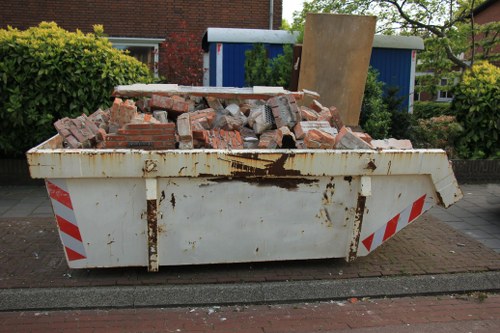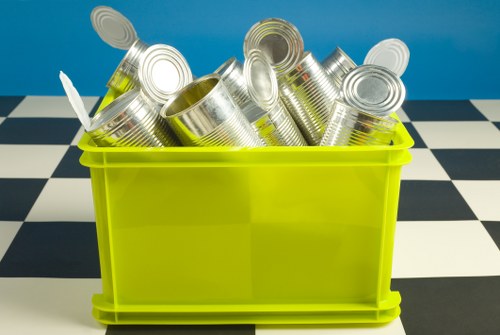Waste Disposal in Snaresbrook: Comprehensive Guide

Introduction to Waste Disposal in Snaresbrook
Waste disposal is a critical aspect of maintaining the cleanliness and sustainability of any community. In Snaresbrook, effective waste management practices are essential to ensure the health and well-being of its residents. This guide provides an in-depth look at the waste disposal options available in Snaresbrook, helping residents understand how to manage their waste responsibly.
Understanding the various types of waste and the appropriate disposal methods is key to minimizing environmental impact. From household waste to recycling and hazardous materials, Snaresbrook offers a range of services to cater to different waste management needs.
In this article, we will explore the different waste disposal services in Snaresbrook, provide tips on reducing waste, and highlight the importance of proper waste management for a sustainable future.

Types of Waste in Snaresbrook
Waste can be categorized into several types, each requiring specific disposal methods. In Snaresbrook, the primary types of waste include:
- Household Waste: Everyday items discarded from homes, such as food scraps, packaging, and non-recyclable materials.
- Recyclable Waste: Materials that can be processed and reused, including paper, glass, metal, and certain plastics.
- Hazardous Waste: Items that pose a risk to health or the environment, such as batteries, chemicals, and electronics.
- Green Waste: Organic waste like garden clippings, leaves, and branches.
Proper segregation of these waste types is crucial to ensure efficient disposal and recycling processes.
By categorizing waste correctly, residents can contribute to reducing landfill usage and promoting recycling initiatives in Snaresbrook.

Household Waste Disposal Services
Snaresbrook offers several options for household waste disposal, making it convenient for residents to manage their everyday trash effectively.
The local council provides regular collection services for general household waste, ensuring that bins are emptied on scheduled days. Additionally, there are specific guidelines on what can and cannot be disposed of with regular trash.
For larger items or bulk waste, Snaresbrook has dedicated collection points where residents can drop off bulky items such as furniture and appliances. This service helps keep the streets clear and ensures that bulky waste is handled properly.

Recycling in Snaresbrook
Recycling is a vital component of waste management in Snaresbrook. The community is encouraged to recycle as much as possible to reduce the strain on landfills and conserve natural resources.
Snaresbrook provides designated recycling bins for different materials, including paper, glass, plastics, and metals. These bins are collected regularly, and the materials are processed for reuse.
Residents can also participate in local recycling programs and initiatives, which often include educational workshops and events aimed at promoting sustainable practices.

Hazardous Waste Management
Handling hazardous waste requires special care to prevent harm to people and the environment. In Snaresbrook, there are specific facilities and guidelines for disposing of hazardous materials safely.
Items such as batteries, paints, solvents, and electronics should not be disposed of with regular household waste. Instead, residents can take advantage of designated drop-off points and scheduled collection events for hazardous waste.
Proper disposal of hazardous materials helps prevent contamination and ensures that these substances are managed in an environmentally responsible manner.
Green Waste Disposal
Green waste disposal is essential for maintaining a healthy environment. Snaresbrook provides services to manage organic waste, which includes garden clippings, leaves, and other biodegradable materials.
Residents are encouraged to compost their green waste or utilize the local green waste collection services. Composting helps reduce the volume of waste sent to landfills and produces valuable compost that can be used to enrich soil.
The community also organizes regular green waste collection events, making it easier for residents to dispose of their organic waste responsibly.
Reducing Waste in Snaresbrook
Reducing waste is a shared responsibility that benefits everyone in the community. Here are some effective strategies residents can adopt to minimize waste:
- Practice Recycling: Always sort and recycle materials appropriately.
- Compost Organic Waste: Turn kitchen scraps and garden waste into compost.
- Reduce Single-Use Items: Opt for reusable bags, bottles, and containers.
- Proper Disposal of E-Waste: Take electronics to designated collection points.
- Avoid Food Waste: Plan meals and store food properly to minimize spoilage.
Implementing these practices not only reduces the amount of waste produced but also promotes a more sustainable lifestyle in Snaresbrook.
Community engagement and education are key to encouraging these habits among residents.
Local Regulations and Guidelines
Understanding local regulations is important for effective waste management. Snaresbrook has specific guidelines that residents must follow to ensure proper waste disposal.
The local council provides comprehensive information on waste collection schedules, acceptable materials, and disposal procedures. Adhering to these regulations helps maintain the cleanliness and orderliness of the community.
Violating waste disposal guidelines can result in fines or other penalties, so it is crucial for residents to stay informed and compliant with the local rules.
Community Initiatives and Programs
Snaresbrook actively promotes waste reduction through various community initiatives and programs. These efforts aim to engage residents in sustainable practices and foster a culture of environmental responsibility.
Examples of such initiatives include recycling drives, educational workshops, and community clean-up events. These programs not only raise awareness but also provide practical tools and resources for effective waste management.
Participation in these initiatives strengthens community bonds and contributes to the overall well-being of Snaresbrook.
Benefits of Proper Waste Disposal
Effective waste disposal offers numerous benefits to the community and the environment. Some of the key advantages include:
- Environmental Protection: Reduces pollution and conserves natural resources.
- Health Improvement: Minimizes the risk of diseases by preventing the accumulation of waste.
- Aesthetic Enhancement: Keeps neighborhoods clean and attractive.
- Economic Savings: Lowers costs associated with waste management and landfill usage.
- Community Pride: Fosters a sense of responsibility and pride among residents.
Embracing proper waste disposal practices leads to a healthier, cleaner, and more sustainable environment for everyone in Snaresbrook.
It is a collective effort that requires the participation and commitment of all community members.
Challenges in Waste Disposal
Despite the available services, waste disposal in Snaresbrook faces several challenges. These include:
- Increasing Waste Volume: Growing population leads to more waste generation.
- Recycling Contamination: Improper sorting reduces the efficiency of recycling programs.
- Limited Space: Landfills near Snaresbrook are reaching capacity.
- Public Awareness: Lack of knowledge about proper waste disposal methods.
- Hazardous Waste Management: Ensuring safe disposal of toxic materials.
Addressing these challenges requires continuous effort, innovation, and community involvement to ensure sustainable waste management in Snaresbrook.
By overcoming these obstacles, Snaresbrook can set an example in effective waste disposal and environmental stewardship.
Future of Waste Disposal in Snaresbrook
The future of waste disposal in Snaresbrook looks promising with ongoing initiatives aimed at improving efficiency and sustainability.
Technological advancements, such as smart waste bins and automated sorting systems, are being explored to enhance waste management processes. These innovations can lead to better resource utilization and reduced operational costs.
Additionally, the community is focusing on promoting a circular economy, where waste is minimized, and materials are continuously reused and recycled. This approach not only benefits the environment but also creates economic opportunities within Snaresbrook.
10-15 Closest Areas to Snaresbrook
Snaresbrook is surrounded by several nearby areas, each offering unique features related to waste disposal:
- Barking: Just north of Snaresbrook, Barking provides additional waste collection points and recycling centers.
- Wanstead: Located to the southwest, Wanstead has specialized facilities for green waste and hazardous materials.
- Ilford: East of Snaresbrook, Ilford offers bulk waste disposal services and community recycling programs.
- Croydon: South of Snaresbrook, Croydon features advanced waste-to-energy plants.
- Leyton: Northwest of Snaresbrook, Leyton provides residential waste collection and composting services.
- Chingford: Northeast, Chingford offers electronic waste recycling and safe disposal options.
- Woodford: West of Snaresbrook, Woodford has comprehensive recycling initiatives and public awareness campaigns.
- Tottenham: Further north, Tottenham supports large-scale waste management projects and education programs.
- Romford: East, Romford includes extensive landfill sites and resource recovery facilities.
- Gants Hill: Directly adjacent, Gants Hill provides local waste collection and reduction strategies.
- Mangapps Cross: Nearby, Mangapps Cross features community-based recycling efforts and green waste services.
- Hainault: To the southeast, Hainault supports eco-friendly waste disposal and minimizing landfill dependency.
- Forest Gate: Southwest, Forest Gate offers diverse waste disposal options and sustainability initiatives.
- South Woodford: Closest to Snaresbrook, South Woodford provides convenient waste collection services.
- Stratford: Further west, Stratford includes modern waste management facilities and recycling centers.
Each of these areas complements Snaresbrook's waste disposal services, ensuring comprehensive coverage and support for the surrounding communities.
Conclusion
Effective waste disposal in Snaresbrook is fundamental to maintaining a clean and healthy environment. By understanding the different types of waste, utilizing available services, and adopting sustainable practices, residents can significantly impact the community's overall well-being.
Community involvement, adherence to local regulations, and continuous improvement of waste management systems are key to overcoming challenges and ensuring a sustainable future for Snaresbrook.
Together, we can make Snaresbrook a model for responsible waste disposal and environmental stewardship.
Frequently Asked Questions (FAQs)
1. How often is household waste collected in Snaresbrook?
Household waste in Snaresbrook is typically collected twice a week. Residents are provided with a schedule by the local council to ensure timely disposal of their household trash.
2. What materials are accepted in the recycling program?
The recycling program in Snaresbrook accepts paper, cardboard, glass bottles and jars, metal cans, and certain plastics. It's important to rinse and sort items properly to avoid contamination.
3. Where can I dispose of hazardous waste in Snaresbrook?
Hazardous waste can be disposed of at designated drop-off points in Snaresbrook or during scheduled collection events organized by the local council. Items such as batteries, chemicals, and electronics should never be placed in regular trash.
4. Is there a bulk waste disposal service available?
Yes, Snaresbrook offers bulk waste disposal services. Residents can schedule pickups for large items like furniture and appliances or drop them off at designated collection points.
5. How can I reduce my household waste?
To reduce household waste, you can practice recycling, compost organic materials, use reusable products, avoid single-use items, and be mindful of your consumption habits. Planning meals and proper food storage can also help minimize food waste.